Typically, nonprofits are not known for having stellar marketing strategies, but there are a few that do stand out. They recognize the power of investing time and energy in marketing to broadcast their message, build a loyal fan base, and obtain donations.
Charity: water, a nonprofit that provides clean and safe drinking water to people in developing nations, is definitely at the top of the list. They are exceptional at inbound marketing. (They focus on creating powerful content to inspire people to join their cause.) And their marketing has tangible results. In 2012 alone, they raised $33 million, of which over $8 million was raised through their online fundraising platform.
Yet charity: water is not just a model for other nonprofits wanting to up their marketing game. There is a lot that for-profit companies can learn from them as well. In the spirit of the holiday season, here are nine marketing lessons businesses can take away from charity: water’s incredible marketing.
1. Encourage Customers to Spread the Word by Sharing Their Personal Experiences with Your Brand
Charity: water truly has mastered the art of getting people to form personal connections with their brand. One of the most powerful ways they’ve done this is by building an online platform that allows people to create fundraising campaigns linked to personal events, such as marathons, holidays, or birthdays.
This is pure genius for enlisting others to spread their message. As each fundraiser shares their campaign with their personal network via word of mouth and online, the number of people who know about charity: water quickly multiplies.
Paull Young, Director of Digital at charity: water, describes the strategy this way: “We are trying to build a movement of passionate people who are going to form a relationship with us for years…. We want our donors to be advocates. We want them to share content, we want them to feel really connected to their impact, and we want them to represent that to all their friends and family.”
At the time of writing this article, nearly 180,000 people have raised collectively almost $29 million on charity: water’s online platform. That’s 180,000 people telling their friends, family, and whoever else follows them online about charity: water. Brilliant!
How can your company apply this? Think of creative ways to encourage people to link important personal experiences and events to your brand. Nike does this again and again with their digital marketing campaigns. An example is The Chance, a campaign designed to give youths around the world the chance to win a year at The Nike Academy.
As a result of the campaign, which first ran in 2010, participants created more than 17,000 Facebook pages that reached an additional 5.5 million fans. Moreover, 2,000 user-generated videos and 28,000 player posts were created, and the brand received 3.4 million YouTube views.
Finally, just as Young talks about building relationships with their donors that, hopefully, will last for years, you should approach your customers with that same mentality. What can you do to make your customers so happy that they’ll become your brand advocates and stick around for the long haul?
2. Tap into the Power of Social Proof
Brian Gardner defines social proof as “the positive influence created when people find out others are doing something – now, suddenly, everyone else wants to do that something, too.”
Charity: water is excellent at using social proof to encourage people to fundraise on their online platform. They employ numbers throughout their site to make people feel aligned with thousands of others, and they give a face and a voice to those thousands with pictures, videos, and written stories.
Here are a few images from the charity: water website that show how they employ social proof.
Social proof is particularly powerful when famous people are setting the example.
On the “birthdays” section of their website, after discovering that many others with the same birthday as you – and 47,492 people in total at the time of this writing – have asked for donations instead of presents for their birthday, charity: water tells you how cool celebrities like Depeche Mode and Tony Hawk pledged their birthdays to the nonprofit.
How can your company apply this? Put customer testimonials on key pages of your website. Include photos whenever possible, and try to get at least a few testimonials from people who are well known in your industry.
Ryan Holiday does a great job of this on his marketing company’s website, with testimonials from Tim Ferriss and infamous celebrities like Tucker Max and Dov Charney.
Also, if your numbers are impressive, find a way to integrate them into your web copy. For example, you can say how many people are currently using your product. Buffer does this on their homepage, where they state that over 1 million people are using their application and that these users have shared more than 100 million pieces of content via Buffer.
Check out this article for a detailed explanation of how to leverage social proof in your marketing efforts.
3. Identify Your Unique Value Proposition and Broadcast It to Your Audience
Charity: water explains clearly on their homepage the three things that make them different from other nonprofits: their 100% model, their emphasis on proving where donations go with GPS tracking, and their collaborations with local partners in the countries to which they supply clean water. Any site visitor thinking about donating to charity: water knows immediately what makes them special.
But charity: water didn’t decide on this value proposition haphazardly. They hit on three major pain points for nonprofit donors:
- Most donors prefer to know that their money goes directly to helping people rather than to operating costs (hence the “100% model”).
- Donors often feel confused about where their money ends up or don’t really trust that it’s being used as promised (hence “proving it”).
- In the nonprofit space, there often is concern about western organizations barging into foreign countries and implementing solutions without really understanding the people’s needs (hence “local partners”).
How can your company apply this? Before deciding on a value proposition, get to know your customers and talk to them about their pain points and what’s most important to them.
Once you’re confident you’ve nailed a unique value proposition that both sets you apart from your competition AND represents what your target market wants, make sure to include it on the most important pages of your website.
Ideally, it will appear in the headline on your homepage and/or product page, but don’t stop there. Follow charity: water´s lead and weave it into other parts of your site, your social media messages, blog posts, and your explainer video.
Charity: water is great at doing this subtly because their value proposition is an integral part of the way the organization operates, and your company’s should be, too.
4. Identify Brand Evangelists within Your Organization
Charity: water’s CEO Scott Harrison is the face of the organization. His personal story of how he went from being a “selfish” nightclub and fashion events promoter to volunteering with Mercy Ships and then starting his own nonprofit, which he tells in nearly every speech he gives, is intertwined with the charity: water brand.
Harrison has over 61.5k followers on Twitter and nearly 10k followers on Instagram. In both social media profiles, his publications are mostly about charity: water, including anecdotes about the team, photos from the field, and retweets from the official charity: water account.
How can your company apply this? People like to associate faces with companies, as it makes them seem more human and less inaccessible. Identify who can be the public face of your company. If not your CEO, then someone else who is high-ranking and who probably will be there for a long time.
You certainly can have more than one brand evangelist. Apple had Steve Jobs and Jony Ive, and each had a different style that worked in different situations. What’s important is that you have employees who embody the company brand, who are (ideally) well known in your industry, and who promote the brand through their personal channels.
5. Harness the Power of Storytelling
Harrison’s emphasis on telling his personal story when he talks about charity: water sets the tone for the organization’s marketing strategy. After all, the people on the charity: water team are masters at storytelling. They do it on Facebook, Twitter, and Instagram, as well as on their blog, their website, and in their email marketing campaigns.
Charity: water even has an entire section of their site dedicated to stories from the field, where people who work for or collaborate with the nonprofit tell stories about the experiences they’ve had delivering clean water to people in Rwanda, Uganda, Bangladesh, and more.
What makes charity: water’s stories so powerful is the use of impactful images and stunning video combined with a very personal, candid style of writing. In fact, Harrison has said that if he talks for an hour, he uses over 200 photos and videos in his presentation.
The video from their 2010 September campaign is a great example of how the nonprofit uses storytelling to communicate its message and inspire donors:
Also, Chartiy: water is excellent at using data to enhance narratives, which they do beautifully on the landing page for their current holiday campaign to furnish water to families in Cambodia. (Hint: roll over each tile for a fun animation.)
How can your company apply this? Make storytelling a central part of your marketing efforts. Tell your company’s and your founder’s stories on the website, and tell your customers’ stories through testimonials and case studies. Use photos and video to compliment each narrative as much as possible.
You also can weave storytelling into your educational blog content. Let’s say your company is a social media agency. One of your community managers can write a post detailing the process he followed to become great at converting leads via social.
Keep in mind that not all stories need to be long-form. Charity: water’s Facebook content shows how you can tell stories in just a sentence or two, like in the post below.
6. Create Content that People Will Fall in Love with
I mentioned above that charity: water raised over $8 million through their online platform last year and $33 million in total. Guess how much they spent on marketing during that same year: just shy of $9k.
Paull Young explains their marketing strategy as such: “At our core, we are an amazing content marketing shop… We don’t buy advertising. We 100% focus on word-of-mouth marketing. We create amazing content that we then distribute through the web – through social media – and then we give that to people we hope are passionate advocates who will take the content and share it with their friends.”
While charity: water sometimes accepts donated advertising space, the majority of their marketing focuses on creating content that inspires and allows people to experience the work that the nonprofit does (and where their donations go) through beautiful design, images, and video.
How can your company apply this? Figure out what inspires your customers and what gets them excited, and then create a content marketing strategy around that. If you’re a Big Data company, perhaps your target customers love looking at beautiful, complex infographics and reading musings on what the impact of Big Data on business will look like in five years. Or perhaps they get inspired by tutorials and how-to’s.
Whatever it may be, take a cue from charity: water and make inspiration a core element of your content strategy. Young says, “Inspired people with the mouthpiece of social media can do amazing things.”
7. Partner with Well-Known Brands and Influencers
By partnering with major brands (such as Toms, Nautica, and American Express) and celebrities (such as Will and Jada Smith and Adrian Grenier), charity: water has been able to amplify its message and reach audiences they might not have reached otherwise.
These brands and celebrities talk about the nonprofit in their social media channels, in videos, and on their website, and they even promote it through their products. Toms has released limited edition charity: water glasses and shoes.
How can your company apply this? You don’t have to partner with A-list celebrities. Instead, start by targeting industry influencers, and make it your goal to convert the most important ones into ambassadors for your brand. In my experience, the best way to do this is by building face-to-face relationships, but social media is a great way to start connecting with influencers.
You also should think about how you can partner with other like-minded brands, including established companies within your industry or bigger consumer brands, if it fits your company’s strategy and style.
8. Be a Brand Purist
When Harrison founded charity: water, he set out to create a great brand that revolved around storytelling with multimedia, inspiring people through highly-sharable content, and connecting people to the impact of their donations, always using beautiful design.
Since then, he and his team have strived for excellence in all the materials they produce. In fact, the second person Harrison hired was a designer. The nonprofit’s web design is pixel-perfect and its printed materials are stunning. I am always excited when I see the charity: water name in my inbox because I know the email will be a joy to look at and fun to read.
In short, charity: water is always on-brand, whether they are launching a landing page for a new campaign, publishing their annual report, sending an invite to their annual gala, or partnering with Jambox to create charity: water-themed wireless speakers.
I couldn't be more excited about the charity: water gala on Dec. 16 – Are you coming? https://t.co/GBIZ3YChNL pic.twitter.com/ZOoasr9dEc
— Scott Harrison (@scottharrison) November 25, 2013
How can your company apply this? Establish clear brand guidelines for your company regarding design, tone of voice, and personality, and make sure the senior team prioritizes brand consistency. Hold yourself and your team to high standards when publishing anything that will be seen by the public. If it´s not in line with your brand guidelines or up to par in terms of quality, tweak it until it’s just right.
9. Get Creative with Your Copy, Especially in Your Headlines and CTAs
I probably could write a book about all the amazing things charity: water does with their marketing, but I know you have important things to do (like applying these nine lessons to your marketing strategy). So I’ll wrap it up by talking about copy.
Charity: water writes great copy. They make their headlines pop with eye-catching numbers and a dash of humor when appropriate. On the web, they break paragraphs into short, easy-to-digest chunks accompanied by photos or graphics. And they have big, beautiful buttons with text that often parts from what you typically see in CTAs.
Here are a few of my favorite headlines from their website and emails:
Here are a few of my favorite buttons:
How can your company apply this? If you want to convert leads or customers online, invest time in learning how to write great copy, or even hire an expert to do it for you. Start by defining a tone of voice that reflects the brand personality you want to convey, and then rewrite the headlines and body copy on the most important pages of your site following web copy best practices.
Joanna Wiebe’s Copy Hacker e-book series is great for learning how to write web copy.
The Crazy Egg website is an example of how web copy can impact your bottom line. Conversion Rate Experts says it grew the company’s web conversions 363% by optimizing copy.
Neil Patel has talked about the importance of creating cult-like connections with your customers (think Apple). Harrison seems to have woven this idea into the foundation of charity: water from the start.
Through a commitment to storytelling, beautiful design, broadcasting a unique value proposition, putting donors at the center of their strategy, and creating highly sharable content, the nonprofit has built a brand that incites the kind of loyalty, excitement, and inspiration most companies dream of.
Throughout the holiday season, charity: water will be raising funds for their Cambodia campaign, which will help provide clean water to more than 15,000 homes in Cambodia.
Learn more here.
About the Author: Chloe Gray specializes in digital marketing strategies for startups and medium-size tech companies. Be sure to say hi to her on Twitter. You also can follow her on Google+, and LinkedIn.
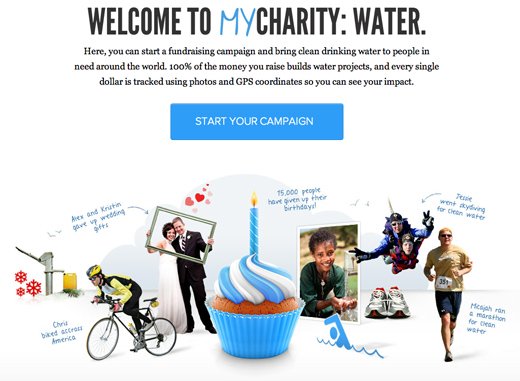
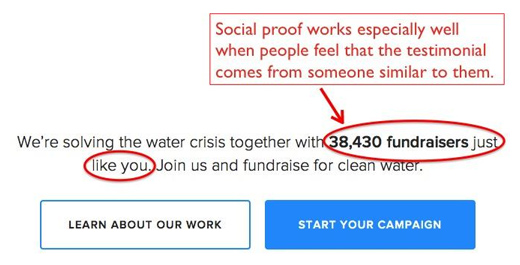
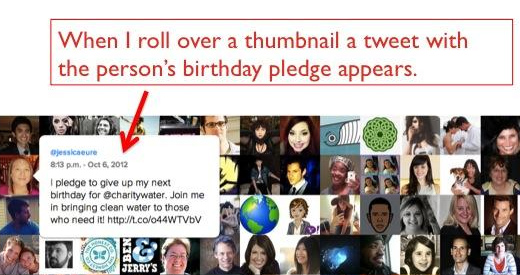
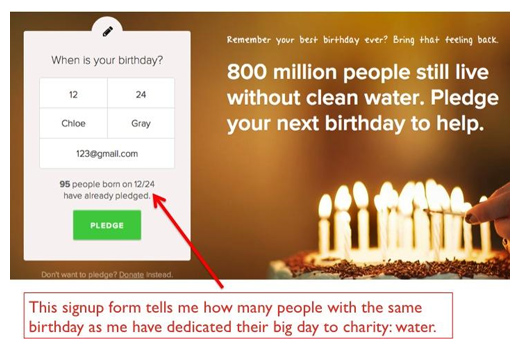
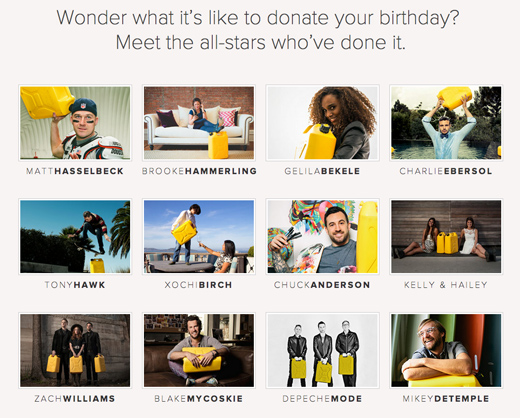


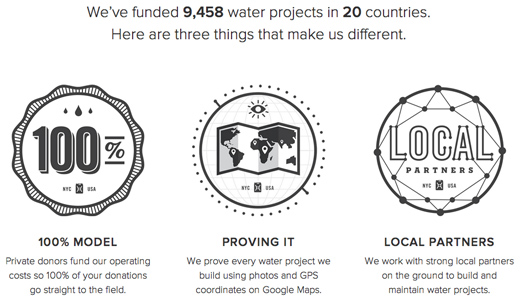



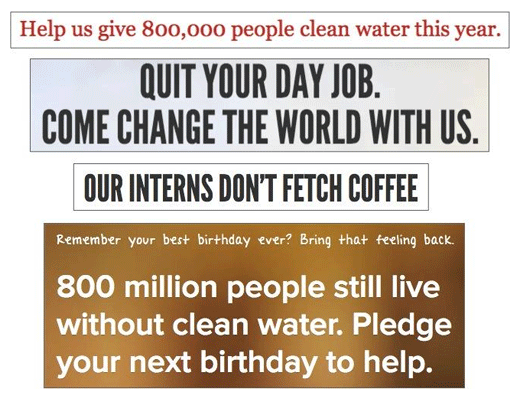
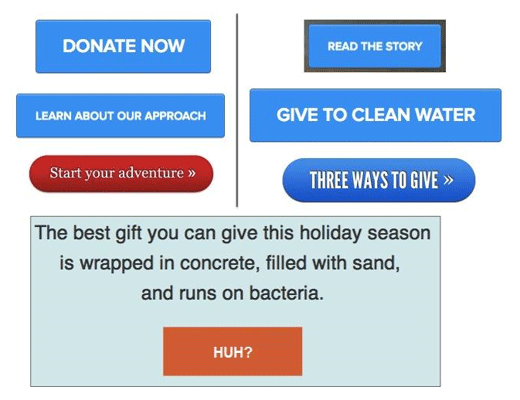
Comments (9)